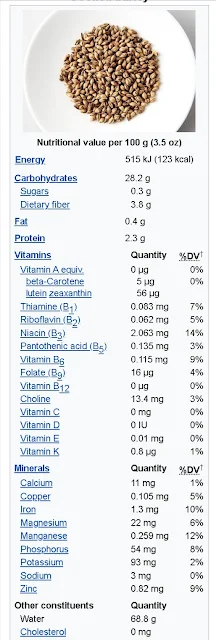Barley is called "Jo" in Hindi.
Traces of Barley cultivation have also been found in post-Neolithic Bronze Age Harappan civilization 5700–3300 years before present
Tibetan barley has been a staple food in Tibetan cuisine since the fifth century CE. This grain, along with a cool climate that permitted storage, produced a civilization that was able to raise great armies. It is made into a flour product called tsampa that is still a staple in Tibet. The flour is roasted and mixed with butter and butter tea to form a stiff dough that is eaten in small balls. (source:en.wikipedia.org)
In ancient Rome, sprouted barley gruel was used as a food for gladiators and also as a staple for the Roman army. Sprouting is known as a way to transform grains or beans into a more nutrient-dense food that is easier to digest. The unique activating procedure, where the grain isn’t sprouted but pre-sprouted instead, uses a low-temperature process that was first used as a replacement for mother’s milk, as a formula for infants who were unable to nurse. The process that is used to activate barley preserves enzyme activity, vitamins, and minerals, bringing it just to the point where it’s ready to sprout then putting it into a state of suspended animation, where it is then transformed into a powder that mixes easily into any drink or recipe.
Barley transforms into a gel in the GI tract, slowing its passage through the body, which in turn allows maximum nutrient absorption. It also stabilizes glucose levels and is great for use by diabetics. Its composition is unique among others, being extremely energy-dense, providing four hundred percent more energy than barley that hasn’t been pre-sprouted. Barley is often used to improve athletic endurance, help maintain healthy cholesterol levels, control hunger, boost the immune system, and detoxify the blood. It has a very low glycemic index, allowing it to be used in low-carbohydrate diets. This superfood is rich in soluble fiber and beta-glucans, which explains its healthy effects on cholesterol, blood sugar balance, and the immune system. The pre-sprouting process is used also to increase the grain’s content of beta-glucan a substance known to boost the immune system. Have you had your barley today?
Cause of Aging in Western World
Most people would be surprised to find out that the number-one cause of premature aging and disease in the Western world is the over-consumption of food. This is true not only because too much food can make us fat, but also because everything we eat must be processed by our bodies, which requires an expenditure of energy. Because the body has to be continually processing calories, we suffer much wear and tear. Within each cell of the human body, vitamins, minerals, antioxidants, healthful fats, and other important nutrients are the important parts that create energy and repair the wear and tear that our body is continually fighting.The modern diet is extremely abundant calories, but yet extremely light on these healing, renewing substances. A diet that is calorie-dense yet nutrient-poor has a serious effect on the state of our health, causing us to be overfed and malnourished.
Why is Barley considered as most energy-efficient food?
Barley in the most energy-efficient food available in nature, having major implications for those who are concerned with maximizing longevity, avoiding disease, increasing athletic performance, and fighting obesity. Barley is much more than a supplement found at your local health food store, it is a complete food that has been converted into a superfood through an all-natural process, making it so powerful and functional that it can be used to nourish those who are struck by famine. Actually, the United Nations uses it as a relief food for those in famine-stricken countries because of its ability to support human life better than any other single food.In ancient Rome, sprouted barley gruel was used as a food for gladiators and also as a staple for the Roman army. Sprouting is known as a way to transform grains or beans into a more nutrient-dense food that is easier to digest. The unique activating procedure, where the grain isn’t sprouted but pre-sprouted instead, uses a low-temperature process that was first used as a replacement for mother’s milk, as a formula for infants who were unable to nurse. The process that is used to activate barley preserves enzyme activity, vitamins, and minerals, bringing it just to the point where it’s ready to sprout then putting it into a state of suspended animation, where it is then transformed into a powder that mixes easily into any drink or recipe.
Barley transforms into a gel in the GI tract, slowing its passage through the body, which in turn allows maximum nutrient absorption. It also stabilizes glucose levels and is great for use by diabetics. Its composition is unique among others, being extremely energy-dense, providing four hundred percent more energy than barley that hasn’t been pre-sprouted. Barley is often used to improve athletic endurance, help maintain healthy cholesterol levels, control hunger, boost the immune system, and detoxify the blood. It has a very low glycemic index, allowing it to be used in low-carbohydrate diets. This superfood is rich in soluble fiber and beta-glucans, which explains its healthy effects on cholesterol, blood sugar balance, and the immune system. The pre-sprouting process is used also to increase the grain’s content of beta-glucan a substance known to boost the immune system. Have you had your barley today?










